Tom Mitchell, Thomas Hale, Sun Yu and Edward White

For Chinese football fans watching World Cup matches on television, the first sign there was something amiss was when they realised they could hear the crowds in the stadium, but could not see them on their screens.
As nationwide protests against President Xi Jinping’s draconian zero-Covid policy gathered pace last weekend, the censors decided it was too embarrassing to see fans enjoying themselves in crowded stadiums in Qatar, with no one wearing a mask. So after every goal, Chinese television feeds focused only on the players and coaches on the pitch and ignored jubilant fans embracing each other in the stands.
It was just one of the many absurdities that, alongside three years of constant lockdowns, mass testing and detention centres for the infected, finally caused public frustrations to boil over.
Just six weeks ago, Xi secured an unprecedented third term in power and seemed to cement his position as China’s most powerful leader since Mao Zedong. But over the course of a few days, the aura of strong, competent authority that the Chinese Communist party’s propaganda apparatus has painstakingly constructed around Xi over the past decade has been punctured.
At one of the higher profile protests in Shanghai on November 26, crowds called on Xi to “step down”. Other chants heard across the country echoed a lone anti-Xi protester who unfurled a banner on an overpass demanding “freedom not lockdowns” in the run-up to the 20th party congress in October.
As one student protester in Shanghai told the Financial Times: “The protests made people realise that Xi isn’t omnipotent.
 Nationwide protests against Xi Jinping’s draconian zero-Covid policy have gathered pace © Noel Celis/AFP/Getty Images
Nationwide protests against Xi Jinping’s draconian zero-Covid policy have gathered pace © Noel Celis/AFP/Getty Images“Zero-Covid is only a surface problem. The real problem is there is no constraint on the state’s intrusion of private citizens’ rights,” added the student, who asked not to be named for fear of police reprisals. “This is the first time meaningful protests happened and it wasn’t an easy decision to join them. It won’t benefit me if I am identified . . . But I felt I should support the pursuit of freedom. I also felt compelled to participate in an event that might make the country a better place.”
More ominously for Xi, the relatively small-scale protests and vigils that received the most attention — generally involving dozens or hundreds of people — masked a much broader rebellion at thousands of residential compounds across the country. People who had been forced to remain in their homes for days or weeks refused to obey confinement orders any longer.
That portends a potentially explosive winter Covid outbreak in a country with 1.4bn people and low vaccination rates among the elderly. In a worst-case scenario, China would experience a replay of the “exit wave” chaos that overwhelmed Hong Kong in February — only on a scale 200-times larger and with a far inferior nationwide medical infrastructure compared with that of the former British colony.
‘Zero-Covid in name only’
In early November the central government issued a list of 20 measures that suggested it was not abandoning zero-Covid, but which did at least relax many of its controls. Inconsistent implementation of the guidelines across many cities and regions initially frustrated those hoping for a return to normalcy.
Over recent days central and local authorities appear to have decided they cannot hold back the tide of people surging out of their locked-down residential compounds. Their bias is now towards ever greater relaxation, which could include isolation at home for confirmed cases and close contacts — rather than being sent to hospitals or centralised facilities. Chen Long at Plenum, a Beijing-based research firm, says the trend is towards “zero-Covid in name only”.
This has coincided with a shift in messaging from senior officials, including vice-premier and Covid tsar Sun Chunlan, that “Omicron’s pathogenicity has geometrically decreased compared with previous strains” of the virus.
Such optimism may prove misplaced. Hong Kong’s spring outbreak was driven by Omicron, as was Taiwan’s more recent and far better-managed exit wave. Taiwan still experienced a 0.2 per cent death rate. “China can’t tolerate a death rate like Taiwan’s,” says one Beijing-based adviser to the Chinese Center for Disease Control and Prevention.
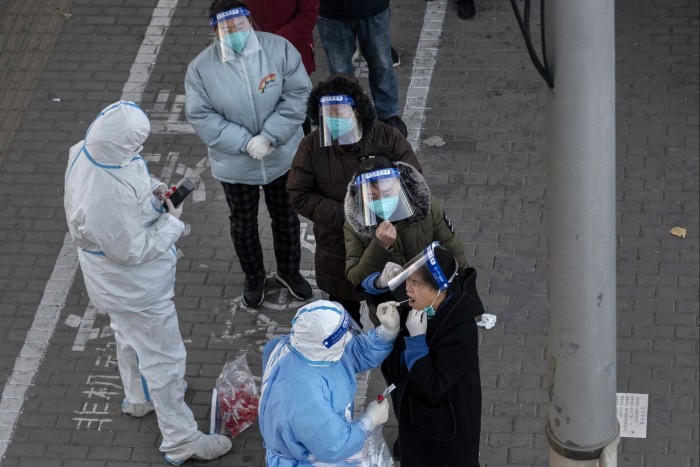
An ‘epidemic control worker’ tests a Beijing resident as other people wait in line before leaving by bus from an area in lockdown last week © Kevin Frayer/Getty Images
The new messaging could also confuse people who accepted Xi’s previous warnings that Covid was a “devil virus” that only an “all-out people’s war” could vanquish.
“According to the 20 measures, the overall direction is to loosen up,” says Yu Jie, a China expert at UK think-tank Chatham House. “However, over the past three years the government’s rhetoric has been ‘this virus is lethal’ and we were insisting on lockdowns to protect life. This has really caused confusion across society.”
The protests had petered out by midweek as police began to track down participants. Chen Wenqing, a former state security minister who now heads the party’s internal security apparatus, vowed to “resolutely crack down on the infiltration and sabotage activities of hostile forces as well as illegal and criminal activities that disturb social order — social stability must be ensured”.
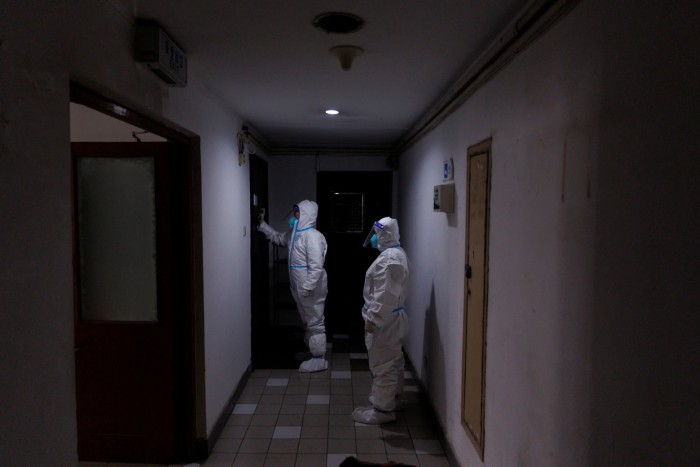 State officials in protective suits knock on a resident’s door in an apartment building that went into lockdown in Beijing last week © Thomas Peter/Reuters
State officials in protective suits knock on a resident’s door in an apartment building that went into lockdown in Beijing last week © Thomas Peter/ReutersBut even if the unrest can be stamped out as quickly as it flared, it will go down as a remarkable moment in modern Chinese history and evidence that the country’s much-vaunted “social stability” is much more brittle than it seems.
“It’s hard to know, refracted through social media, the scale of what we’re seeing,” says John Delury, a Sinologist at Yonsei University in Seoul. “But you’ve got at least half a dozen major cities seeing political street protests of the kind that just is not part of Chinese life and hasn’t been for decades.
“I don’t know if people can appreciate just how unusual this is in a Chinese context,” he adds. “To hear these spontaneous groups chanting ‘we want freedom’, singing protest anthems and ironically using patriotic songs to protest the lockdowns — it’s astonishing.”
Lance Gore, a China expert at the National University of Singapore, agrees that “it’s hard to assess — it’s widespread but how deep this goes we don’t know.
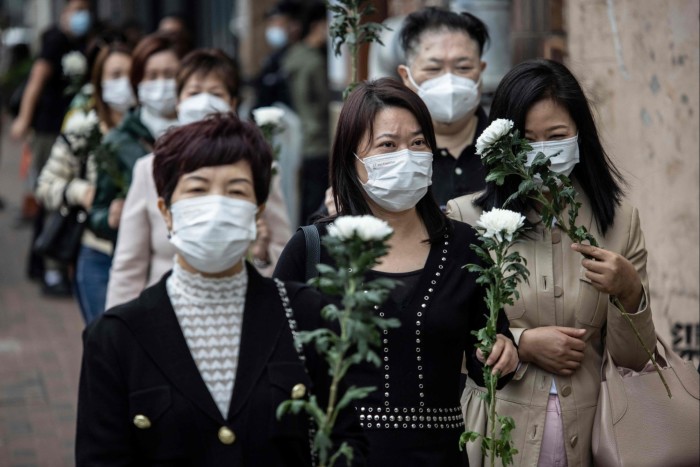 People queue with flowers near the Chinese Liaison Office in Hong Kong to pay their respects following the death of Jiang Zemin on November 30 © Isaac Lawrence/AFP/Getty Images
People queue with flowers near the Chinese Liaison Office in Hong Kong to pay their respects following the death of Jiang Zemin on November 30 © Isaac Lawrence/AFP/Getty Images“Xi should learn something from this,” adds Gore, who was born in Maoist China and attended university in Beijing in the mid-1980s — a time of economic, cultural and political ferment launched by Deng Xiaoping’s “reform and opening” policies that culminated with mass pro-democracy protests and the Tiananmen Square massacre in the spring of 1989. “He’s not God. He can’t control everything. He needs to learn that modern government involves negotiation, compromise and give-and-take.”
The death of Jiang Zemin, the former president and party general secretary who guided China out of its post-Tiananmen torpor, added to the sense of momentousness surrounding the week’s developments.
Jiang, whose passing at the age of 96 was announced by state media on Wednesday, was no political liberal. Under his leadership, the party continued to crush dissent. But alongside his tough and competent premier, Zhu Rongji, Jiang engineered bold economic and financial reforms and negotiated China’s entry into the World Trade Organization. He also presided over a period of relative cultural openness, at least compared with the grinding conservatism and control-freakery that have defined Xi’s decade in power.
Out of the fire
The humbling of Xi Jinping began on the night of November 25 when hundreds, and perhaps thousands, of protesters marched on government headquarters in Ürümqi, the capital of the northwestern Xinjiang region where 10 people had died a day earlier in a residential tower fire. Both on the streets of Ürümqi and online, people blamed pandemic controls for impeding residents’ escape from the inferno and firefighters’ arrival — allegations strenuously denied by municipal officials.
The denials did not matter because, even if true, most people simply did not believe them and had had enough of zero-Covid.
Over the following two days there were vigils and protests in dozens of cities and university campuses to mourn the victims of the Ürümqi tragedy. In Shanghai people gathered along a road named after Xinjiang’s capital.
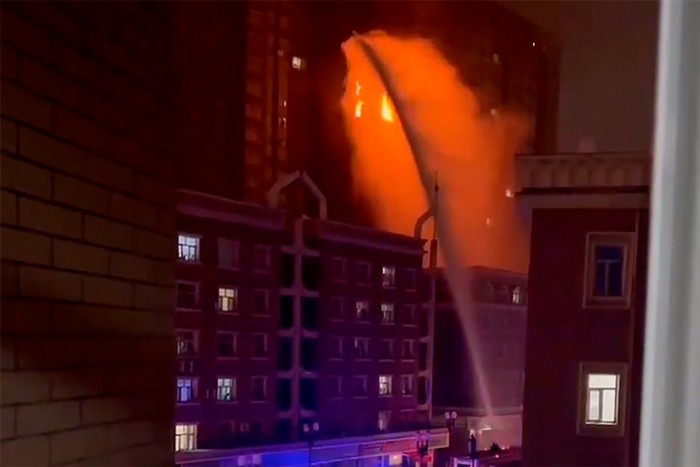 Firefighters douse a blaze at a residential building in Ürümqi in western China’s Xinjiang region on November 24. Protests erupted the next day after 10 people perished in the inferno and locals blamed pandemic controls for impeding their escape © AP
Firefighters douse a blaze at a residential building in Ürümqi in western China’s Xinjiang region on November 24. Protests erupted the next day after 10 people perished in the inferno and locals blamed pandemic controls for impeding their escape © APThe largest and most violent unrest appeared to occur on November 27 in Wuhan, the pandemic’s epicentre, as large crowds roamed the city, pulling apart fences penning people inside residential compounds and workplaces.
“Protesters tore down metal barriers around shops and residential compounds,” says one participant, who estimated that tens of thousands of people were involved. “Residents who were released joined us and we went to release more people and neighbourhoods together.”
Some of the protests were notable for flashes of wit and humour, as people called out the absurdity of a system they previously dared not criticise openly.
Even the police occasionally seemed sympathetic. One police officer in Beijing urged people to disperse because their gathering could spread Covid, to which a protester countered that it was no more crowded than many testing facilities that people routinely queue up at in large numbers. “That problem,” the police officer agreed wearily, “is another problem.”
When it was suggested that the protests were being instigated by “foreign forces”, a participant shot back with: “What foreign forces, Marx and Engels? Was the Ürümqi fire caused by foreign forces?”
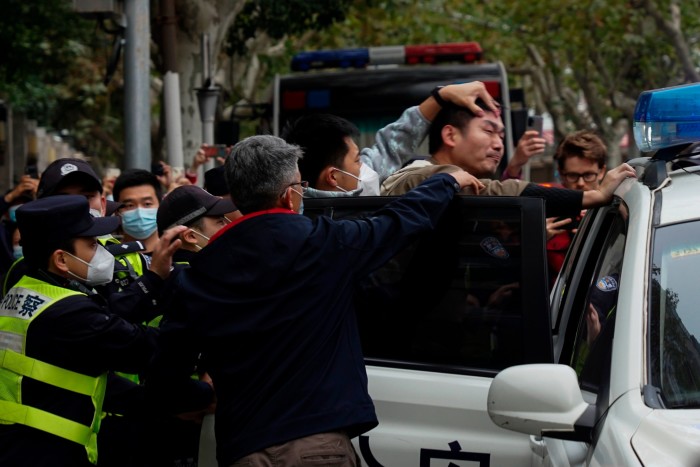
A protester is forced into a police car during a demonstration against Xi Jinping in Shanghai on November 27 © AP
And if police or campus authorities seized blank paper held up by protesters — a protest against censorship first popularised in Hong Kong — they sometimes improvised by pretending to hold up imaginary pieces of paper. In Shanghai, one person said people managed to sneak past the police cordon around the protest zone “by telling them they needed to do Covid tests nearby”. It wasn’t long before police cottoned on to the ruse.
But many protesters say the initial sense of liberation they felt last weekend faded quickly as police flooded likely gathering places to prevent more demonstrations.
A second person who attended the Shanghai protest says it was disheartening that there was not more support across the country. He adds that he is now “ashamed” he did not support the large-scale pro-democracy protests in Hong Kong in 2019.
He has since come to realise that “China is a huge machine, not a normal modern country; many poor and unlucky people become fuel to keep this machine running”.
A third person in Shanghai — a student — agrees that she too felt “very disappointed” about conditions in China. But she also felt hopeful, adding that “I can see the future in the people who protested”.
No comments:
Post a Comment